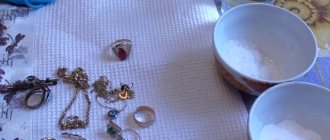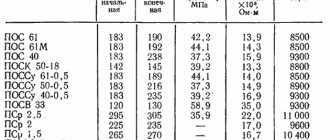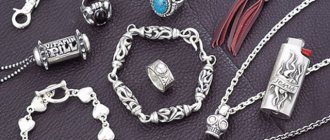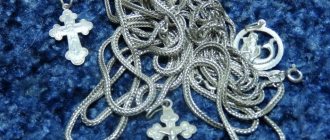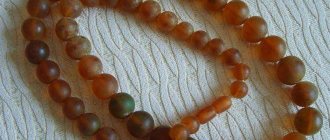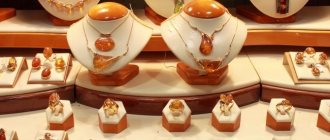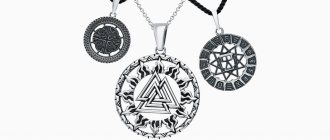No matter how beautiful natural amber is, people have been trying to improve the quality of the gem for many years. The craftsmen who processed amber wanted to achieve complete transparency of amber and expand its color range. The processed mineral was valued much higher and was used to make jewelry.
One of the most ancient methods of processing amber is enlightenment. For this purpose, the fat of a young pig was used; when boiled in the fat, the bubbles present in the gem in large quantities were gradually filled with fat, and the stone became transparent. Then, instead of pork fat, they began to use linseed or rapeseed oil. In the 19th century, enlightened amber was used to make magnifying glasses and glasses. Amber glass ignited gunpowder faster than regular glass, so burning glasses were also made from amber.
Another method of processing amber is calcination. Using this processing method, amber is clarified and a husk of “fish scales” appears inside the stone. The essence of this method is to heat the amber in sand at a temperature of 140-150 degrees.
In each era, one or another color of amber was valued differently, so coloring amber was also very widely used by craftsmen. Even in ancient Rome, they learned to give a gem a red tint, which was very much valued at that time: for this, amber was boiled in goat fat or oil at a temperature of 150-200 degrees, and sea purple, which was extracted from shellfish, and alizarin were added as a pigment to fix the color. , indigo and other natural dyes. The main criterion when choosing a dye is that it must be soluble in oil.
Also, to give amber reddish shades, they used to boil the gem in honey, but this very often resulted in the formation of a fine network of cracks on the surface of the stone, so this method was not popular.
Today, clarification is also used as a method of processing amber; cloudy or dirty yellow amber is decolorized in special autoclaves, the stones are kept under pressure for 16 hours in a nitrogen environment at a temperature of 250 degrees, and then the clarified amber is hardened in specialized furnaces with sand.
Another method of processing amber is pressing and molding. Pieces of amber are very plastic when heated, and it is this property that is used when pressing. The gem is first cleaned of the oxidized crust, the oxidized crust of the resin is removed for several hours in a drum in which the stones are spinning; at the bottom of this drum there is a grinding wheel, against which the stones rub. Then the amber is ground into powder and placed in molds. At a temperature of 180-220 degrees and pressure, the powder turns into a viscous mass, then it is poured into molds and allowed to harden while cooling. After pressing, amber of various shades is obtained, thanks to the addition of dyes to the mass; such amber is used in the jewelry industry, for the manufacture of medical utensils and is used in industry as an insulator.
How to distinguish pressed amber
The physicochemical properties of natural solid amber and ambroid, molded stone are similar, but there are some differences. Pressed is characterized by:
- Evenly distributed inside the inclusion, approximately the same spherical bubbles differ from the chaotic ones in size and distribution in the natural “mineral”;
- presence of dye clots;
- a type of “patchwork” quilt;
- the structural distribution of material in stone can be spiral-shaped or rectilinear;
- under UV radiation it behaves like an artificial material, transmitting rays and does not reflect blue or green like natural stone.
The most important difference between ambroid (fused pressed amber) is the reaction to ether. If you moisten the surface of a natural stone with a drop of ether, it will not change, but the pressed one will become sticky and change color at the site of reaction.
Chemical processing of amber is also used. Residues from the processing of large stones are heated in tanks at a temperature of 350-370 degrees, and as a result of chemical reactions, amber decomposes into amber oil (15% of the total mass), succinic acid (1.2%), and “fused amber” (65% ).
Necessary tools for work
First you will need a benchtop lathe with suitable cutters or a jigsaw, a file, a thin narrow hacksaw, pliers, a knife, and a chisel. Tools do not have to be made of durable steel. Amber is a soft material, so even copper is sufficient.
If you need to get rid of scratches on the surface of a stone, sand it, polish it, you will need sandpaper, medium sandpaper and fine sandpaper (waterproof). They use pumice - volcanic hardened foam. It is better not to take artificial one, as it crumbles more easily. In addition, natural has more pores, so it is lighter.
To make holes in the petrified resin, take a drill, screwdriver, or drill. Drill - spiral, feather, size - about 1 mm. Finding this is problematic, so it is sometimes replaced with a needle, sharpened with wire or something similar.
If amber processing involves cutting, it is advisable to have a special device. It is extremely difficult to maintain the angles correctly by hand by eye. You can make a simple support sleeve, a retainer. It is convenient to use a diamond, cast iron or lead polishing wheel. In the last two cases, you will need silicon carbide powder of 8-12 microns.
A wooden circle is perfect for polishing. When tumbling, a special drum is used.
Gluing a gem
Sometimes it is necessary to firmly connect the amber parts together. For gluing use:
- 50% aqueous solution of sodium or potassium, which is used to lubricate the surfaces of the parts, then heated to a certain temperature and pressed tightly together;
- amber varnish and sodium alcohol solution;
- celluloid solution;
- solution of solid copal in ether.
General rules of care
In order for the stone to remain sparkling, it requires care. It is useful to learn how to properly clean amber jewelry:
- To care for amber, only soft fabric (flannel, velvet, fleece, microfiber) is suitable. It is recommended to use a new one.
- Smooth beads and cabochon inserts are cleaned with a napkin. Embossed, in gold, in a different frame - with a cotton swab, a brush with natural bristles, a soft toothbrush.
- After each water procedure, the amber is rinsed and immediately wiped dry. If you put it off until later, the stones will fade again.
- Stones cleared of dirt are polished. Oil is applied to fabric or palms, but not to stones. Each bead or insert is rubbed separately in a circular, leisurely motion.
- Polishing amber is time-consuming: to clean amber beads at home, you will have to sacrifice your weekend. But without it, restoring shine is problematic. New amber is polished at the factory to make it shine.
Cleaning natural amber at home will become less tedious if you wipe off sweat and dust from the jewelry immediately after wearing it.
Washing with clean warm water is beneficial.
Annealing
This method improves the decorative properties of natural pieces of amber. Raw amber is placed in specialized furnaces with sand and subjected to intense heat at temperatures above 200 C. As a result, the stone becomes transparent due to the fact that gas bubbles that cloud the amber come out of it. When heated for a long time, the shade of amber becomes golden yellow. At the same time, numerous cracks form inside the gem, which makes the stone “shiny” when light passing through the stone is refracted through them.
In addition to refining the amber, each stone undergoes standard processing, which includes: peeling, cutting, shaping, grinding and polishing.
Price
Domestic jewelry brands present an assortment of rings, earrings, and pendants. Frame – gold (red, 585°), gilded silver (925°), just silver. All jewelry uses pressed amber (this is indicated on the tag or in the product description), so the cost is determined more by the material of the frame than by the insert.
Product price range (thousand rubles):
- gold – 8.6 – 42.5;
- gilded silver – 2.9 – 5.9;
- silver – 0.9 – 2.6.
Original works include bracelets, necklaces, and earrings that combine wood, textiles, and beads with colored amber. The price of jewelry is one to three thousand rubles.
The cost of paintings is 1.5 – 135 thousand rubles; depends on the dimensions of the canvas, the quantity and condition of the amber chips.
Dossier on a familiar stranger
According to one version, the word “amber” comes from the Lithuanian gintāras, which translates as “protector from disease.” By origin, it is a fossilized resin of coniferous trees that grew on our planet millions of years ago. There are more than 250 types of amber of a wide variety of colors: in addition to the usual orange-reddish-golden one, there is also blue, indigo, black, green and even colorless amber.
The largest amber deposit is located in Russia, near Kaliningrad. Almost 80% of the total volume of solar stone on the world market is mined here. There are also large deposits of amber in Ukraine, Burma, Lebanon, Thailand, Mexico, Nicaragua and the Dominican Republic.
REVIEW AND ANALYSIS OF ADHESIVES USED IN THE JEWELRY INDUSTRY
Currently, enterprises in the USSR jewelry industry use adhesive compositions that do not fully satisfy the stringent specific requirements set by the industry for adhesives and adhesive joints. The choice of certain adhesive materials by enterprises is mainly random, while in practice the technology of gluing substrates with the selected adhesives is often grossly violated, which leads to a significant decrease in the strength of adhesive joints, and this gives rise to an unjustified mistrust of gluing in general.
Conscious selection of the optimal adhesive composition and gluing technology parameters for specific materials requires the simultaneous assessment of a number of factors. Due to the fact that in almost all contact pairs under consideration one of the substrates is metal, from the entire variety of synthetic adhesives, in the opinion of the authors, only adhesives that have sufficient adhesive ability to metal should be taken into account.
Given the specific nature of jewelry, you should exclude adhesives whose curing requires either high temperature or high pressure upon contact of the parts being glued.
When choosing adhesives, it is necessary to take into account the requirements of the jewelry industry for the manufacturability of adhesive operations. In accordance with these requirements, an adhesive composition can be considered technologically advanced if it meets the following conditions: single-component, non-toxic, easy to store, fast curing, ease of application to bonded surfaces, the widest possible range of applications, and accessibility.
It is quite natural that when choosing an adhesive, the main requirement remains the formation of a sufficiently strong adhesive joint that is resistant to variable temperatures, humidity, and various environments possible under the operating conditions of the product. In some cases, for example, when gluing an amber-amber contact pair, the glue, in addition, must be colorless and transparent.
In the jewelry industry, adhesive compositions are used for gluing contact pairs: metal - stone, stone - stone, metal - decorative inserts (amber, pearls, glass, polystyrene, etc.).
Using adhesive compositions, product elements are fastened both at the finishing and at intermediate auxiliary operations, after which the adhesive seam is deliberately destroyed. In intermediate operations, mainly so-called mastics are used, which, depending on their purpose, have different compositions, but follow one general scheme (table): adhesive (shellac, rosin, ED-5 or ED-6 resin) - plasticizer (mainly beeswax) and filler (marble powder, aluminum oxide, chalk).
In some cases, when the adhesive seam is hidden, mastic compositions are used in the final setting operation.
The general disadvantages of mastic compositions are the following: multicomponent nature, the need to use elevated temperatures when gluing, and if they are used in the final operation, the ability to form difficult-to-remove colored streaks on the product.
Phenol-polyvinylbutyral adhesives - BF-2 and BF-4 - are widely used in the practice of adhesive fastening of inserts in products manufactured by Soyuzyuvelirprom enterprises. The disadvantages of adhesives of this type include: the content of a solvent in the adhesive, which, evaporating during use, increases the viscosity, which makes it difficult to apply the adhesive and leads to a deterioration in the strength properties of the adhesive joints; gluing technology requires mandatory “open holding” operations and curing at elevated temperatures, which complicates the gluing process. If these requirements are not met, sufficient strength of the adhesive joints is not ensured. An additional limitation to the use of BF type adhesives in the jewelry industry is the coloring of these compositions.
Glue No. 88, used by some enterprises of Soyuzyuvelirprom (for example, the Kharkov Jewelry Factory) has similar disadvantages for fixing inserts made of colored stones and gems into castes of products.
For gluing amber parts with fittings made of precious and non-ferrous metals, the Kaliningrad Amber Plant uses its own polyvinyl butyral glue:
| Polyvinyl butyral adhesive (butvar) GOST 9439-60 | ………….100 g |
| Ethyl hydrolytic alcohol GOST 8314-57 | ………….500 ml |
| Benzene (analytical grade) OST 5955-51 | ………….500 ml |
The glue consumption is high - 0.335 g per product. The presence of a component such as benzene in the glue formulation indicates its significant toxicity, and the need for “open exposure” (15-20 minutes) and subsequent curing at a temperature of 90-100 ° C for 2 hours, followed by exposure to air for 24 an hour - to its obvious low-tech.
At some jewelry enterprises (in particular, in Sverdlovsk), along with the use of BF-type adhesives, epoxy resin (for example ED-5) is used for gluing contact pairs: stone - stone and metal - stone. At the same time, it should be noted that in the industry as a whole, the use of epoxy compounds is currently very limited, which is due to their lack of technological effectiveness and other disadvantages.
Adhesive setting of inserts made of colored stones and semi-precious stones, amber and pearls into products made of precious and base metals is widely used abroad. The most widely used adhesives in the jewelry industry in foreign countries include epoxy and cyanoacrylate adhesives. The group of epoxy adhesives includes: Araldite (Switzerland) Lepox (Czechoslovakia) and Japanese glue - Hi-Supeg, used for fastening inserts (mainly pearls) into products both at foreign jewelry enterprises and at Soyuzyuvelirprom enterprises (for example, LPTO "Russian Gems" , Bronnitsky and Yerevan jewelry factories, etc.).
Adhesives based on epoxy resins (including Hi-Super) cannot be recommended for widespread use in the domestic jewelry industry due to their low technology: two-component nature, limited viability, difficulty in applying to bonded surfaces, etc., as well as due to relatively high toxicity.
Cyanoacrylate adhesives are a one-component system, based on monomers of alkyl-(aryl)-α-cyanoacrylates, capable of gluing metals, glass, amber, pearls, plastics and other non-metallic materials in various combinations, quickly curing under the influence of traces of air moisture at room temperature . Adhesives based on cyanoacrylates, compared to epoxy ones, have become more widespread in foreign practice. Cyanoacrylate adhesives successfully used abroad in jewelry include: Cyanobond-5000, Supercement-1000, Tsemedin-3000 (Japan), Aron-Alfa (Japan, USA), Tikso K-1 (Sweden), Eastman-910 ( USA).
In recent years, in our country, INEOS AS USSR has developed methods for the synthesis of monomeric cyanoacrylates - alkyl-(aryl)-α-cyanoacrylates. The following monomers were obtained and studied as adhesives: methyl, -ethyl, -n-propyl, -n-butyl, -n-amyl, -n-hexyl, allyl-, β-(3-methoxyethyl, -β-butoxyethyl-α -cyanoacrylates. These monomers themselves are adhesives. However, on their basis a number of compositions have been prepared containing a thickener, plasticizer, stabilizer and other additives. Cyanoacrylate adhesives of various brands, obtained at INEOS AN USSR, have the common name Cyacrin.
As a result of the work carried out to test such compositions in various fields of technology and medicine, it became possible to introduce the synthesis of Cyacrine glue into industry and use it in a number of sectors of the national economy. It seems that Cyacrin adhesive compositions, which meet most of the requirements set by the jewelry industry for adhesives and adhesive joints, should become widespread both in the operations of adhesive setting of inserts and in other operations related to the manufacture of jewelry.
jewelpreciousmetal.com
Amber in applied art: mosaic. Part 7
Paintings made from pieces of natural amber have their own rich history. Each pebble is selected according to size, color and pattern. The most significant and famous monument to the history of this art is the amber room, which was created in the Catherine Palace near St. Petersburg in the 18th century. The room is called the eighth wonder of the world. But during the Second World War, the amber room was barbarically destroyed and taken out of the country. The total area of the amber drawings was several tens of square meters. To produce a unique work of art, hundreds of kilograms of selected amber were spent. Today they are trying to recreate the lost room again. The best specialists in amber art are engaged in the revival of a lost masterpiece.
As in creating any other mosaic, the amber sketch is first carefully developed. Special samples are selected with the crust removed in advance and then sawed into three-millimeter plates. For works of smaller sizes, the base is selected from ply plywood, boards, hardboard, particle boards and metal plates.
The thickness of such bases directly depends on the size of future paintings. The edges of the bases are framed with metal strips or thin slats, which give the product its final appearance. In addition to appearance, they do not allow drops of glue and pieces of amber to protrude beyond the edges of the mosaic. If the amber painting has decorative edges, then the strips are removable.
The type of mosaic technique is determined by the complexity of the selected pattern:
- The usual technique involves fixing the stones to the base with a gap of no more than 1.5 mm. Pieces of gems are usually selected to be the same size. In small works, the size of each pebble can be from 5 to 6 mm. Pieces of amber are split or cut, a certain area of the design is smeared with glue, which should be the same color, and then the cut stones are evenly laid on it, leaving a thin gap. Laying amber in a mosaic begins with the central part of the image, gradually moving to the edges.
- The Florentine technique or intarsia involves gluing stones without gaps, as tightly as possible to each other. The design is designed precisely so that each color is cut from the same material. The image on paper is cut into separate pieces, each of which is then glued onto a plate of the same size and color using PVA glue. After this, the finished plate is filed with jigsaws and sharpened with a file on an electric sharpener. Having received the stone part, it is soaked and then the paper is carefully removed.
It is better to type a mosaic picture on a glass plate. Tracing paper is placed under it so that the glue cannot stick to the glass, and the original is compared with the resulting image. When the dry selection of parts is completed, the new pattern is secured along the edges with strips. The image is filled with glue, after which it is placed on a suitable base and placed under a press.
The glue can be PVA, putty, BF-2 or 4 glue, epoxy glue, etc. The composition of BF-2 in this case is more suitable for intarsia. The surface of the design and its base are degreased with alcohol and thinly lubricated with glue. The work is dried for 20 minutes, then it is re-spread with glue, and after 5 minutes the base is applied to the mosaic and pressed with a press. The product takes up to two days to dry.
PVA glue is very convenient to use. After drying, it forms a viscous, durable, almost colorless and transparent film, although it is not resistant to moisture. Putty or putty is prepared using this glue. It is used to fill voids formed after completion of work or to repair products. To do this, moisten the amber powder with glue and mix well. After the glued pieces of gems have dried, the resulting web from the gap is carefully filled. Only now is the work finally dried, sanded and polished.
| Popular goods |
ukrburshtyn.com

